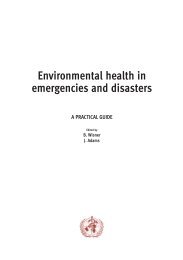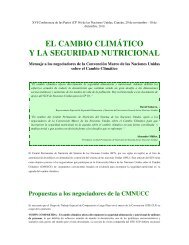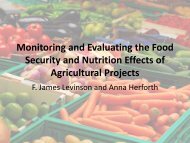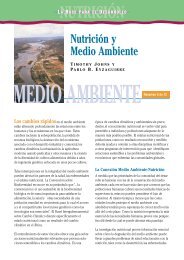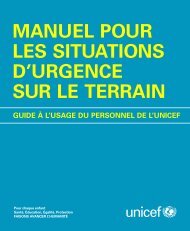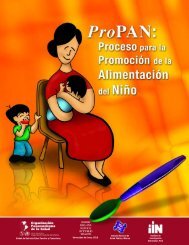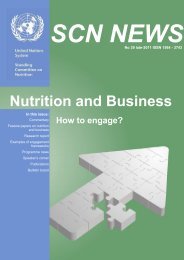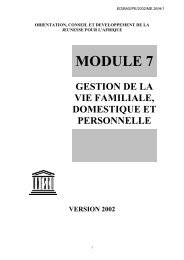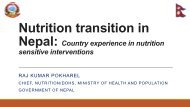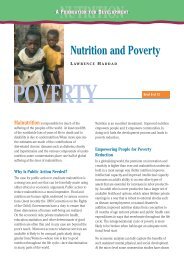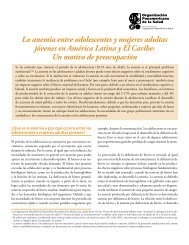SCN News No 36 - UNSCN
SCN News No 36 - UNSCN
SCN News No 36 - UNSCN
You also want an ePaper? Increase the reach of your titles
YUMPU automatically turns print PDFs into web optimized ePapers that Google loves.
www.unsystem.org/scn 63<br />
Comments to the Lancet Nutrition Series<br />
In addition to the comments from the Working Groups on the preceding pages, the <strong>SCN</strong> Secretariat has received this article by<br />
Briend et al as a comment to the Lancet Nutrition Series.<br />
Management of severe acute malnutrition<br />
A comment to the Lancet Series on maternal and child nutrition<br />
André Briend (WHO), Zita Weise-Prinzo (WHO), Flora Sibanda-Mulder (UNICEF), Tanya Khara (UNICEF), Martin Bloem (WFP),<br />
Tina van den Briel (WFP) and Claudine Prudhon (<strong>SCN</strong>)<br />
We welcome the new Lancet Series on Maternal and Child Undernutrition, an excellent opportunity to galvanise the nutrition<br />
community and governments into common action. The Series rightly identifies severe acute malnutrition (SAM) as an<br />
important cause of child death and lists its treatment among the recommended priority interventions. Paper 3 of the Series,<br />
however, only recommends the scale up and improvement of hospital based SAM management to prevent this important<br />
cause of death. We agree that improvement of hospital-based management is indeed important, and an integral<br />
part of a strategy to address SAM. However, documented experience in countries - especially developing countries -<br />
demonstrates that hospital-based management reaches only a small percentage of children and falls far short of a sufficient<br />
response (Schoffield and Ashworth 1996, Briend 2001, Karaolis et al 2007). On the other hand, the addition of a<br />
community based component leads to a sharp increase in programme coverage (Sadler et al 2007).<br />
This motivated UN agencies and partners to review the evidence of the effectiveness of a community-based approach<br />
relying on ready-to-use therapeutic foods (RUTF) to treat children in their own homes at an informal WHO/UNICEF/WFP/<br />
<strong>SCN</strong> meeting held in <strong>No</strong>vember 2005 (Prudhon et al 2006) As a result of the review, WHO, UNICEF, WFP and <strong>SCN</strong> recommended<br />
concerted action to develop and strengthen the community-based component of SAM management as a<br />
means of reaching the majority of children suffering from SAM (WHO/WFP/UN<strong>SCN</strong>/UNICEF 2007). This recommendation<br />
is already bringing partners and governments together to address this important cause of child mortality.<br />
The authors of the Lancet Series do acknowledge that observational data based on large scale programmes from Ethiopia,<br />
Malawi and Sudan suggest that the community based approach is largely successful (Collins et al 2006). We very much<br />
support the inclusion of this type of observational evidence in paper 3 of the series, as for evaluating large-scale interventions,<br />
studies with plausibility designs are often the only feasible option and may provide valid evidence of impact (Victoria<br />
et al 2004). This is particularly true in the case of community-based management of SAM.<br />
The authors state that their methodology included identifying unpublished literature by contacting experts and agencies<br />
that work on undernutrition. Again we very much support this, given the large amount of unpublished literature that is<br />
building on the subject of community-based management of SAM. Growing numbers of programme reports of a whole<br />
range of agencies (such as Concern Worldwide, Save the Children UK and US, MSF, CARE, ACF, Tearfund, World Vision),<br />
show that the community based approach allows the successful treatment of unprecedented large numbers of children<br />
with SAM. They also provide valuable evidence of the effectiveness of the approach. Examples of this type of literature<br />
are available on the web (Chamois 2006, Defourny et al 2006).<br />
It would have been useful to have a more detailed set of recommendations on the type of research recommended for<br />
covering the gaps the authors summarize in the evidence-gap section. The present UN recommendation is to implement<br />
both the community and facility based treatment in parallel, the community component ensuring a high coverage, and<br />
the facility component also providing medical treatment for complicated cases recognising that strong ongoing monitoring<br />
of these programmes is vital (WHO/WFP/UN<strong>SCN</strong>/UNICEF 2007). Robust experiments, as suggested by the authors<br />
of the Lancet Series, that test these components in isolation would deprive some children of optimal treatment and lead<br />
to unnecessary deaths. Specifically, through hospital care children would not be reached due to low coverage and in<br />
community-based care children with medical complications would not receive adequate medical treatment.<br />
In conclusion, while the importance of the Lancet series for prioritizing research as well as interventions is evident, we<br />
would like to greater recognition for the need to promote the new community based approach as an integral part of the<br />
management of children with SAM (WHO/WFP/UN<strong>SCN</strong>/UNICEF 2007). This is critical if we are to reach the majority of<br />
children with SAM at the large-scale required to significantly impact this important cause of death.<br />
Contact: brienda@who.int<br />
The authors declare no conflict of interest. AB and ZWP are staff members of the World Health Organization. These authors alone are<br />
responsible for the views expressed in this publication and they do not necessarily represent the decisions or stated policies of the<br />
World Health Organization.<br />
References<br />
Briend A (2001) Management of severe malnutrition: efficacious or effective? J Pediatr Gastroenterol Nutr 32: 521-2.<br />
Chamois S (2006) Ethiopia Experience in the Management of Severe Acute Malnutrition (2003-2005). <strong>SCN</strong> <strong>News</strong> 33: 45-48. (online)<br />
back to contents <strong>SCN</strong> NEWS # <strong>36</strong>




